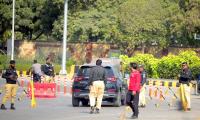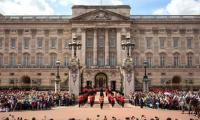Horrible tragedies befall nations when real politic overwhelms the larger dominant interests of its people providing eager enemies lurking around in anticipation of any signs of weakness to exploit and rip one apart. The same happened with East Pakistan, the misrule, mistrust turning into a toxic environment ending in a cataclysmic episode of country’s history.
In a recent book that uncovers and establishes the Indian Navy’s clandestine terrorism and covert actions in East Pakistan, now Bangladesh, in 1971, "Operation X: The Untold Story of India’s Covert Naval War in East Pakistan" by Sandeep Unnithan and Captain M.N.R. Samant, gives a very graphic account of how the Indian naval intelligence under direct orders from the naval chief Admiral Nanda trained and equipped the refugees from East Pakistan to direct a seaborne insurgency against the Pakistan Navy.
India had long been cultivating assets in East Pakistan and assigned them various missions in sabotage and subversion. Like the person who tried to take Pilot Officer Rashid Minhas' aircraft to India, there were men in the navy too assigned to do just that. The Pakistan Navy submariners were training on a new Daphne class submarine PNS Mangro in Toulon, France. Working in the shadows with their Indian Navy handlers, 11 sailors and officers, led by Abdul Wahed Chowdhury and Lt Commander Moazzam Hossain, tried to take over the submarine, kill and imprison the patriotic officers and to commandeer it to the subcontinental theatre of Pak-India hostilities for launching attacks against Pakistan’s commercial and naval ports and ships. By sheer luck, the Pakistan Naval Intelligence came to learn of the plot and threw a dragnet before the plan could be executed. This followed an intense gunfight, killing one of the dissident officials, while the 10 others including Abdul Wahed Chowdhury, who had led the mutiny along with Lt Commander Moazzam Hossain, managed to escape. Like the classic cloak and dagger operations, with the help of Indian intelligence tentacles, one of them reached London, the others went to Marseilles and from Madrid, finally reached Geneva, Switzerland, and made their way to the ultimate destination, the Indian Embassy.
They were provided with passports and on April 9 they flew for Bombay on board an Air India flight. Welcomed by their handlers on reaching India, they were taken to New Delhi where the next darker and ominous chapter was to be unfolded.
Writing about the book, Sandeep Unnithan, who is the main author of the book, says "the Indian Navy, which stood frustrated and helpless during the 1965 war with Pakistan, saw a fleeting opportunity in 1971 to redeem themselves." Covert operations, Unnithan says, always have a larger strategic game plan, but the desperation of Admiral S.M. Nanda, India’s naval chief, to ensure that the Indian Navy plays an important part in the Bangladesh Liberation landscape was the driving force.
Historically, during the 1965 war with Pakistan, the Indian Navy could not get any real chance of significantly taking part in the war. Most of their assets were forced to remain docked in the ports by the Pakistani subs lurking outside their major naval ports, the strategic radar station Dwarka was destroyed plunging them into a virtual communication dark… though they did carry out some tactical actions but 1971 gave them the opportunity to salvage what they had lost.
After the aborted attempt to hijack a Pakistani submarine, the Indian naval chief found another use for the defecting submariners. The Bengali officers were privy to valuable and valid intelligence on Pak Navy’s assets, command nodes, strength, deployments, naval infrastructure and communication facilities in East Pakistan, giving a deep insight to the planners about the Pakistan Navy’s plans and actions. Pakistan’s counterterrorism, counterinsurgency and counter intelligence campaigns led by operations Searchlight and Barisal had trounced Mukti Bahni and driven them back to India where it was modified into a guerrilla warfare.
Admiral Nanda and Director Intelligence Captain Mihir Roy strategized to subvert and sabotage Pakistan’s SLOCs (sea lines of communication) in the East Pakistan theatre through a dirty and dangerous sea-based insurgency. Bangladesh is dotted with canals and sea ports that are critical to economy and logistics and by the same argument served as lifeline for the Pakistani troops fighting treason and hostile enemy action in 1971. This led to putting Operation X into action, by raising an expendable Mukti Bahni saboteur force to wage sea-based insurgency to destroy Pakistan’s war waging potential. Indian intelligence's long-time asset, Abdul Wahed Chowdhury, who had led the submariners revolt in France, offered himself eagerly for the new task, in return for political asylum in India.
The eight Bengali submariners along with nine active duty Indian Navy personnel began to run a training and operational camp near Plassey, Krishnanagar, West Bengal. The Camp 2 Plassey, code named C2P was supervised by Commander Samant (co-author) who later also directed the insurgent actions. There was another similar camp in Tripura too. Around 150 East Pakistani youth were selected from the refugee camps and trained in combat diving, mine-laying, underwater demolitions and small arms firing.
The Operation-X had different components including Operation Jackpot and Force Alpha and triggered a murky new power play. The Operation Jackpot was aimed to attack and sabotage the riverine and sea commercial and naval ports and destroy the naval and commercial boats and ships bringing essential military supplies from West Pakistan and those that could pose any threat in the naval actions.
With the help of border guards and the Indian Army, four groups of trained and equipped Mukti Bahni terrorists were sneaked into East Pakistan and brought to the staging areas by August 12. Under a predetermined arrangement, the Calcutta Radio had to broadcast songs, at specific time, containing coded instructions to mount the vicious attack. The first "warning" song was played on 13 August and the second "action" song on 14 August. Taking cue on Aug 16, Chittagong and Mongla sea ports and critical Chandpur and Narayanganj river ports were attacked, damaging the ports' infrastructure and several ships and other platforms, rendering them out of action. According to Pakistan Navy officers in know of things, but not cleared to speak on record about them, the initial attacks which caught them off guard, followed a string of other attempts on the oil depots at Narayanganj, Bogra, Faridpur and Chittagong but security and patrolling actions and engagements with the terrorist groups prevented the sabotage attempts. All subversive actions to take out the critical Hardinge Bridge were also foiled. They recalled local security and the SSG Navy ambushed some of the Mukti Bahni groups at their safe houses, killing some and rounding up several others. This was one part only.
Under the Operation X, Admiral Nanda had also trained the Mukti Bahni saboteurs to carry out mining operations at the sea ports using gunboats, alongside attacking unsuspecting Pakistan Navy ships and boats by a task force code named Force Alpha. The Indian Navy provided two of the three gunboats for the task force.
The Force Alpha comprising gunboats Palash and Padma, accompanied by INS Panvel, under the command of their camp coordinator Commander M. N. Samant, were ordered to mine Mongla port. But on way to the mission they were attacked and destroyed by the Indian Air Force jets in the Pussur River in a case of friendly fire, thus bringing an end to the misadventure.
Those were difficult and tragic times for Pakistan and India used all its resources to destabilize but things have changed little since then; RAW's terrorist actions in Pakistan continue to this day.
Militants entered from Afghanistan a month ago and were well-trained, says DIG CTD KP Hassan Raza
Petitioner submitts it essential to establish Election Tribunal in consultation with CJ of relevant high court
Marwat reveals certain groups within PTI engage only in criticising central leadership via social media
Earthquake's epicentre was located in Hindu Kush region of Afghanistan at depth of 220 kilometres
Wah Saddar Police arrest criminal Zabaghat with 3.2 kilograms of hashish
Negligence may cause loss of lives in terms of an increase in HIV-positive patients after dialysis of an HIV carrier







